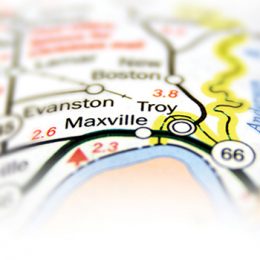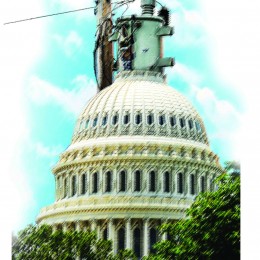 Early in the classic film “Gone with the Wind,” before the Civil War blows their world away, Scarlett O’Hara’s father says to her: “Do you mean to tell me, Katie Scarlett O’Hara, … that land doesn’t mean anything to you? Why, land is the only thing in the world worth workin’ for, worth fightin’ for, worth dyin’ for, because it’s the only thing that lasts.”
Early in the classic film “Gone with the Wind,” before the Civil War blows their world away, Scarlett O’Hara’s father says to her: “Do you mean to tell me, Katie Scarlett O’Hara, … that land doesn’t mean anything to you? Why, land is the only thing in the world worth workin’ for, worth fightin’ for, worth dyin’ for, because it’s the only thing that lasts.”
Besides land, and, most of us would probably add, our American freedoms and equality, there is another thing certainly worth working for and fighting for. And, sadly, some have died for, too, while building and maintaining it. “It” began 75 years ago, just before “Gone with the Wind” was filmed. Though it’s tied to the land and those who work it, it has not lasted this long, and will not continue to last, without active grassroots support.
“It” is the affordable electricity for all Americans that President Franklin Roosevelt and like-minded rural Americans brought forth in 1935. That’s when FDR created the Rural Electrification Administration and the electric cooperative movement was born. Ever since, consumer-owned, not-for-profit electric co-ops and the REA (now known as the Rural Utilities Service) have been one of the greatest private-public partnerships in history.
The promise of affordable electricity was appropriately underscored, celebrated and renewed at the national electric cooperative’s annual meeting in Atlanta this February.
Themed “Tough Choices Call for Strong Voices,” the meeting was held in the state where “Gone with the Wind” takes place and where Roosevelt was first inspired to make sure electricity was made affordable for all Americans.
At his cottage in Warm Springs, Ga., where he went in 1924 to seek relief for his paralysis, Roosevelt was infuriated by his 18-cent per kilowatt-hour electric rate. That was four times the rate he paid at his Hyde Park, N.Y., estate. It was a problem he decided to do something about after he was elected president in 1932.
At that time, only one in 10 farms and homes in rural America had “central station” electricity delivered by wires. Rural folks who did get electricity paid higher rates to make sure the “public” utilities recovered that added heavy investment. Rural Americans suffered a lower quality of life without electricity. Their health, wealth and education were all being hindered by the lack of it.
Indiana was one of the first states to push for electric cooperation in 1935. Written by the Indiana Farm Bureau Cooperative, the Indiana REMC Act sailed unanimously through both houses of the Indiana General Assembly and was signed into law by Gov. Paul McNutt in March 1935.
Two months later, through an executive order, President Roosevelt established the REA as an emergency relief agency, creating a federal source of loans for utilities willing to electrify the vast, unserved areas of rural America. Immediately, newly-created Indiana Statewide REMC began helping local co-ops form. In 1936, Roosevelt signed the Rural Electrification Act that passed through Congress with bipartisan support to make the REA a permanent lending and support agency.
Today, though, the affordable electricity for the masses that Roosevelt helped bring about is being threatened by a three-pronged attack from Washington. This is the same Washington that, ironically, claims to be FDR’s heirs.
The coming decisions on climate change legislation in Congress and carbon regulation from the U.S. Environmental Protection Agency could easily bring 18-cent (or more) kWhs back to not only Warm Springs, but to Indiana and most all of rural America heavily dependent on fossil fuels for electricity.
In addition, President Obama’s proposed 2011 budget hacks $2.6 billion from the RUS electric loan program — loans to ensure that rural consumers continue to have safe, reliable and at-cost supplies of power from their not-for-profit co-ops. Meanwhile, the administration left untouched generous tax breaks to the rest of the electric utility industry.
The nation’s electric co-ops were built by progressive thinkers. That’s a legacy that continues. Co-ops are leaders in promoting energy efficiency and conservation, and use a higher percentage mix of alternative energy than any segment of the electric industry.
But almost three-quarters of the electricity consumed in the U.S. is still generated from fossil fuels. The short-sighted solutions to supplant fossil fuels and curb carbon dioxide being bandied about in Washington are unrealistic, at best. That is, unless, as Gov. Mitch Daniels told Indiana’s co-op leaders in December, the U.S. wants to just “default and accept Second World-status economically.”
Electric cooperatives ask consumers who believe electricity needs to be kept affordable for all Americans to please go to the “Our Energy, Our Future” Web site at ourenergy.coop.
Tell those in Washington to work with electric co-ops on climate solutions that are
realistic and affordable and to support adequate RUS funding. Please thank those members of Congress who have already done so.
Without your voices being heard, the affordable and reliable electricity that rural Americans have built, defended and advanced for 75 years, may soon, too, be gone with the wind.



